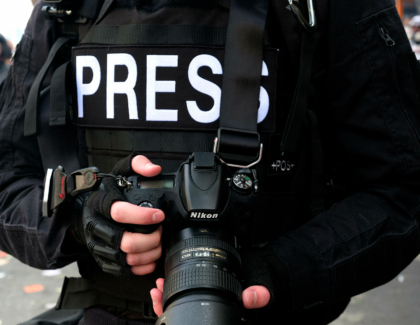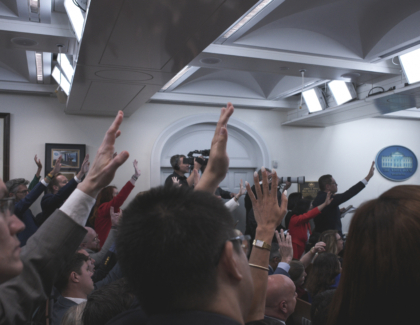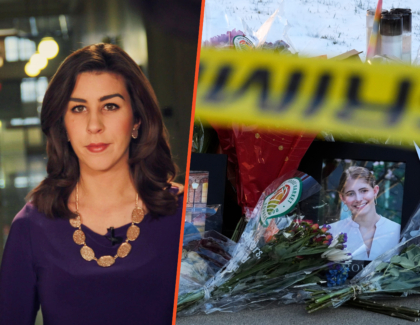Sign up for the daily CJR newsletter.
Even before the World Health Organization declared COVID-19 a public health emergency of international concern in January 2020, there were debates as to where—and how—the virus originated. Some cited the emergence of the earliest COVID cases in or around Wuhan, in China, as evidence of what came to be known as the “lab leak” theory of the disease’s origin, since scientists had studied coronaviruses similar to the one that caused COVID at an institute in the city. However, most scientists—at least in the initial stages of the pandemic—argued that COVID likely emerged in a manner similar to other diseases caused by coronaviruses: as a result of interspecies transmission, specifically at a so-called “wet” market in Wuhan, where live bats and other animals were sold.
That didn’t stop members of the Trump administration from promoting the idea of a lab leak, which conveniently allowed the White House to shift blame for COVID to the Chinese government. As the virus continued to spread, so did various versions of the theory. In February 2021, Facebook finally announced that it would remove any posts suggesting that the COVID virus was “man-made or manufactured,” and said that it reserved the right to permanently remove any accounts or pages that repeatedly shared such claims. The ban, however, only lasted until May of the same year, when Meta, Facebook’s parent company, said that it would no longer remove such claims, citing what it called “ongoing investigations” into the virus’s origins.
Meta’s ban of the lab-leak theory and subsequent reversal were quickly incorporated into a conservative worldview in which so-called authorities on COVID were inherently untrustworthy. As my colleague Jon Allsop pointed out at the time, a wave of commentators (often, though by no means always, on the right) argued that the media had failed in its duty to report accurately on COVID’s origins, claiming that many journalists had inappropriately discounted the lab-leak argument as a racist conspiracy theory when in fact the science wasn’t yet settled. (Matthew Yglesias described it as a “genuinely catastrophic media fuckup” and “a huge fiasco.”) As Allsop noted, however, the wave of commentary was not based on any new smoking gun proving that COVID had come from a lab. And so the debate over its origins continued.
Alongside this rational, if often heated, scientific disagreement about accidental emergence, darker theories about malign intentions spread. These included the outlandish idea that China and/or the US had developed COVID as a secret bioweapon. There were also whispers about a conspiracy among high-ranking officials including Anthony Fauci, then a top COVID adviser to President Biden, and the WHO to subjugate the world’s populace by spreading rumors of a pandemic that were unfounded to begin with.
This week, some such theories were in the news again—thanks not to online extremists, but to members of Congress (not that those are mutually exclusive categories these days). The Republican-led House Select Subcommittee on the Coronavirus Pandemic called Fauci—now retired, but still a boogeyman for right-wingers—to testify, and grilled him about various aspects of his performance during the pandemic.
Nicole Malliotakis, a Republican who represents a district covering parts of Brooklyn and Staten Island, asked Fauci how much money he had received in royalties from pharmaceutical companies, implying that his advice about COVID was a quid pro quo; Fauci replied that he never received any money, aside from 122 dollars for a monoclonal antibody that he developed in the nineties. Marjorie Taylor Greene, of Georgia, refused to address Fauci as “doctor,” saying that he didn’t deserve such respect; she also shouted that he “belongs in prison.” And a research grant from the National Institute of Allergy and Infectious Diseases (which Fauci led) to an American nonprofit that partnered with scientists from the Wuhan virology lab (among other researchers) was offered as evidence that COVID not only originated in the lab but that the US was complicit. (In a post on X last year, Greene stated that the virus “wasn’t created by bats in a wet market, it was manufactured in a lab funded by Fauci. He covered it up.”)
When Malliotakis asked about the lab-leak theory, Fauci responded that he remains open to the idea that COVID might have escaped from a lab. “What is conspiracy,” he said, “is the kind of distortions of that particular subject,” including the suggestion that “I was parachuted into the CIA like Jason Bourne and told the CIA they shouldn’t be talking about a lab leak.” He also told the committee that he and his wife and three children continue to receive death threats, and that conspiracy theories about his involvement in the origins of COVID are part of the reason why.
In addition to this week’s congressional theater, right-wing politicians have claimed that Fauci played a key role in a coordinated campaign by the Biden administration to strong-arm Facebook and other social platforms into removing posts about vaccines, the lab-leak theory, and other controversial matters. These and other allegations were included in a lawsuit that the attorneys general of Missouri and Louisiana filed against the administration in 2022, in which they accused it of breaching the First Amendment by informally pressuring the platforms to restrict certain kinds of speech, a process known as “jawboning.” (I wrote about the case for CJR last July and again in March, after it reached the Supreme Court.)
The uncomfortable truth is that, four and a half years after COVID first appeared, there is still no consensus on where it originated, even if the deranged conspiracy theories about Fauci and others can be safely ruled out. Even scientists who specialize in virology can’t seem to agree. Writing in the New York Times this week, a molecular biologist who works for an institute backed by Harvard and the Massachusetts Institute of Technology argued that COVID most likely escaped from a lab, based on a number of points that she articulated. And yet, just hours after that op-ed was published, a virologist went through it point by point on X and argued that the evidence remains unclear. In a recently published survey of more than a hundred and fifty virologists, epidemiologists, and other researchers, a slim majority said they believe that COVID likely emerged naturally from transmission between infected animals.
Writing in Wired in 2021, Adam Rogers described the lab-leak theory as a “tale of weaponized uncertainty.” As Allsop also noted, Rogers wrote that the evidence either for or against the theory had not, to that point, “changed since the spring of 2020. That evidence was always incomplete, and may never be complete.” This is the nature of scientific inquiry, as Rogers noted—a sometimes halting, two steps forward, one step back process of trying to arrive at the truth. For journalists, Allsop wrote that the path forward on the lab-leak story was “the same as it always should have been: cover the context, respect the uncertainty, and report out the underpinning truth.” As Rogers pointed out, though, some of those commenting on the theory—and its on-again, off-again status as a conspiracy—weren’t actually interested in the truth. They wanted instead to amplify and in some cases even create doubt, and then leverage that doubt into power. Some of them, clearly, still do.
Part of the problem with stories like COVID is that the weaponization of uncertainty also plays into a “horse race” style of reporting that some outlets favor, in which both sides are assumed to be equally legitimate regardless of the facts, and every new development is seen as a win or a loss for one side or the other. In that sense, the lab leak is the perfect storm: since even scientists who specialize in viruses and epidemiology can’t agree on how COVID originated, anything goes. All that’s required is to pick a side, and then accuse those who disagree of being part of some dark cabal whose intentions fit your political narrative. And with each essay and political op-ed, the truth recedes a little further—until, soon, it is completely out of sight.
Other notable stories:
- This week, the board of the Columbia Law Review, a journal edited by students at Columbia, took the publication’s website offline after it published an essay by a Palestinian scholar outlining a new legal framework for the displacement of Palestinians; the board, which includes Columbia faculty and alumni, said that many students on the Review hadn’t been consulted on the article—but its move was highly unusual, and editors defended the rigor of their processes. In related news, a student newspaper at Stanford said that one of its reporters was arrested while covering a campus occupation in solidarity with Palestine. And the New York Times reports that the Israeli government commissioned and funded an online influence campaign that has targeted pro-Israel messaging at US lawmakers and members of the public, including via fake news sites.
- Also for the Times, Benjamin Mullin and Katie Robertson report that Will Lewis, the publisher of the Washington Post, clashed recently with Sally Buzbee, the paper’s now-former editor, after she informed him of plans to cover legal proceedings in the UK in which Lewis has been accused of covering up illegal reporting practices when he worked for Rupert Murdoch’s British media business in the 2010s. Lewis told Buzbee that the case did not merit coverage and blasted her news judgment; he did not block an article from being published, but Semafor subsequently reported that a Post editor told colleagues not to promote it. Buzbee resigned over the weekend amid a broader shake-up. The Times reports that the coverage clash was not the “primary reason” for her decision.
- In other news about the media business, Shane Smith, the cofounder of Vice Media, is back at the company as editor in chief of Vice News—though Vice no longer has a day-to-day news division and Smith will have “no management responsibility,” per the Wall Street Journal. (He will host a podcast featuring Bill Maher as a recurring guest.) Elsewhere, journalists at eight publications owned by Alden Global Capital, including the Orlando Sentinel and the Hartford Courant, ratified a union contract after years of talks. And Sam Davis is retiring as managing editor of the Baltimore Sun—the first major leadership change since David Smith, the chairman of Sinclair, acquired the paper from Alden.
- Recently, we noted in this newsletter a controversy at the French publishing giant Hachette, which fired Isabelle Saporta as the head of Fayard, a leading Hachette brand, after she refused to share the brand with another editor, Lise Boëll, who is known for her work with right-wing authors including the commentator and former presidential candidate Éric Zemmour. Now Hachette has appointed Boëll to lead Fayard. Hachette has been owned since last year by the company of Vincent Bolloré, a right-wing billionaire who has been accused of dragging various news outlets to the right.
- And, for The Atlantic, Lawrence Wood explains how he became “the Ken Jennings of the New Yorker caption contest”; he holds the all-time record for the competition, having won it on eight occasions and made the final round on seven others. “When I meet new people, I never bring up the contest on my own—deep down, though, I hope someone else will, because it’s all I want to talk about,” Wood writes. “You can imagine my delight when an editor at The Atlantic asked me to write this article.”
ICYMI: Xiao Qiang on the anniversary of Tiananmen Square and the right to information in China
Has America ever needed a media defender more than now? Help us by joining CJR today.







